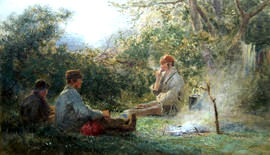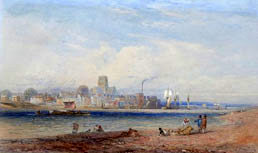HINE, Henry George (1811-1895)
Henry George Hine was born at Brighton, Sussex on 15 August 1811 and baptised on 2 September 1811, youngest son of William Hine, a coachmaster, and his wife Mary née Roffey. A self-taught artist being encouraged by the local rector to copy works by Copley Fielding (1787-1855), that he owned. After painting Sussex sea-pieces and coastal scenes for some years, he was apprenticed to London engraver Henry Hoppner Meyer (1780-1847) and, after spending two years in Rouen, in 1841 became a wood engraver for Ebenezer Landells (1808-1860) working for 'Punch' magazine. Hine's first contribution appeared in the September 1841 issue, and he continued to work for 'Punch' until 1844, after which he contributed to several short-lived rival publications such as 'Puck', 'The Man in the Moon' and the 'Illustrated London News'. He then returned to his landscape painting and Henry exhibited at the Suffolk Fine Arts Association at Ipswich in 1850, two oils 'The Birth-place of a River' and 'Interior at Bramber, Sussex' and eight watercolours 'Interior of Notre-Dame du Bon Secours, near Rouen', 'The Morning after a Gale', 'The Chimney Sweep', 'The Business of Childhood', 'Hampstead Heath, Twilight', 'The Experimental Squadron', 'Rip Van Winkle awakening from his Twenty Years Sleep' and 'Toys of Age'. He also exhibited at the Royal Academy and at the Paris Exhibition in 1878. In 1863 Hine was elected an Associate of the Institute of Painters in Water Colours and a full member in 1864, exhibiting 'St Paul's from Fleet Street' and was a regular contributor to the exhibitions, of which he was the vice-president 1888-1895. He married at Kennington, London on 13 November 1840, Mary Ann Eliza Egerton (1817-25 July 1901) and had a family of ten daughters and four sons, including Harry Hine, and they lived at various addresses in London, in 1851 Cornwall Place, St Pancras, in 1861 Highgate, in 1871 Park Road, Hampstead and in 1891 Gayton Crescent, Rosslyn Hill, Hampstead where Henry George Hine died of bronchitis on 16 March 1895. In 1913 three of his daughters, Esther, Elizabeth, and Marion were granted a civil list pension in recognition of their father's eminence in painting in watercolours.
Royal Academy Exhibits
from 53 East Street, Brighton, Sussex
1830 96 Don Quixote in the Sable Mountain
1839 1110 The Interior of the cloister of Rouen Cathedral
from 22 Brecknock Street, Camden Town, London
1847 528 Sunset in the Hills
1851 963 The Experimental Squadron
1199 The Climbing Boy
1235 A Fellow of the Society of Antiquaries
from 4 Fortess Terrace, West Kentish Town, London
1859 419 Smugglers waiting for a Lugger
Works by This Artist

|
Gypsies Around a Camp FireWatercolour on paper
|

|
Dog Cart and Gentlemen, ShorehamWatercolour
|